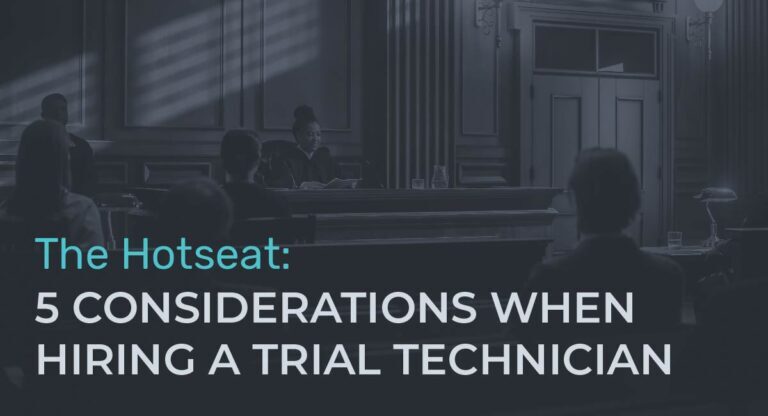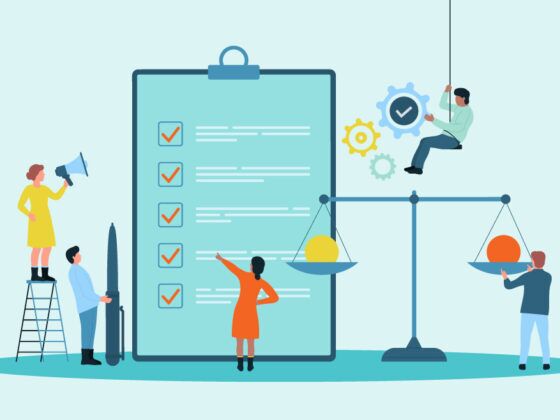A “hotseater,” or trial technician, will allow you to focus on delivering a winning argument by taking care of the technical aspects of trial presentation.
You can’t practice law without a legitimate license, and you can’t go to trial without a compelling presentation. But how do you find time to put slides and documents together? What happens when the computer conks out? Who can make those inevitable last-minute changes to the presentation? A hotseater can handle all of these technical challenges.
Those are all excellent reasons to seek out an experienced and professional trial technician, more commonly known as a hot-seat operator or “hotseater.” They take all the stress off your shoulders so you can focus on arguing the merits of your case.
Here are 5 tips and “best practices” to keep in mind when working with a “hotseater” for your next hearing or trial:
1. When Do You Need a Hotseater?
Your job is to be persuasive, and the hotseater’s job is to make sure your points are dynamically presented in the clearest detail, all without a hitch. Don’t make the mistake of trying to do this on your own or pawning it off to someone less experienced – this is a critical component of your trial that requires the skill and finesse of a professional.
Technology should not be an afterthought. When utilized correctly, it can help keep the attention of your audience on what you want them to remember. Think about how an image, graphic, or animation can support a point you need to make, and the hotseater will do their best to make it happen.
For example, you might set up an easel in the courtroom to hold a large timeline on foam board, but it might be difficult to read. It can be much more impactful if you walk your audience through each event as a build in Microsoft PowerPoint. This helps you break down complex concepts and scenarios into more understandable chunks, and an experienced hotseater can make a big difference.
2. Hire a Professional
Not only can a professional hotseater transform your vision into a reality on screen, they can help provide you with ideas on presenting information, from creating “callouts” on documents to exporting video clips. It may even be something as simple as suggesting that you use a different color on an image to make it stand out and look more professional.
An experienced trial technician will also be comfortable with all the setup and logistics of getting the hardware ready so you don’t have to worry about it. For example, they can determine the necessary cords and extension cables to make sure all hardware is operational, and they’ll tape everything down so you don’t trip while questioning a witness. A hotseater can set up and take down the equipment, confirm all the files are in the proper format, ensure backup plans are in place, run the presentation, and generally make sure everything is working.
3. Scope Out the Location
An experienced and professional hotseater knows to scope out the location of the presentation before the big day. Every courtroom is different, and a hotseater will want to locate all the power outlets in the room (if any) and make sure they bring plenty of power strips, extension cords, and cables to traverse whatever distance is necessary.
Some courtrooms are well-equipped with a newer widescreen TV, while others are still using outdated VGA projectors. A hotseater will come prepared to connect to whatever is present and available in the room, or decide to bring their own equipment (if allowed).
Your team should also check to see if reliable internet access is available. In some situations, it might be safer and more dependable to bring your own hotspot. Having internet access is probably necessary for the presentation, but it’s absolutely mandatory for the trial team to communicate with each other and back to the home office – another critical task the hotseater can help facilitate.
4. Planning and Preparation
As with most successful ventures in life, planning and preparation is paramount. When it comes to successfully presenting information at trial, an experienced hotseater will walk you through all the steps so all parties involved are as prepared as possible.
For example, you must establish a good plan for communication with the hotseater so they show the correct document at the proper time. Sharing an outline of the documents and images you plan to present will help tremendously, even if you need to make changes at the last minute or go off-script.
Part of this requires a consistent way to reference documents – you may internally allude to an important document as the “Smith letter,” but that name won’t mean much to the hotseater when you need it pulled up on screen. Agreeing on a consistent naming structure (e.g. exhibit number) will save time and prevent embarrassing mishaps.
5. Train and Practice… And Then Practice Some More
Did we already mention planning and preparation are important? Then we’ll mention it again. Putting all this together requires practice time to make sure the communication is in place, the hardware is functioning smoothly, backups are secure, the cables are all taped down, and the internet is accessible and reliable.
No matter how much practice time you put in, there will still be problems and challenges on the day of trial, and that’s why we call it the “hot seat.” When the power goes out, the software crashes, or the judge makes you redact passages at the last minute, you’ll be grateful for a professional hotseater with a cool head to get you back up and running.
Looking for a Hotseater or Other Trial Assistance?
Reach out to Nextpoint. Our legal experts can sit next to you at trial and make sure everything runs smoothly. Our graphic designers can transform a basic presentation so that it’s dynamic and compelling to your audience. With years of firsthand trial experience, our litigation services team is here to help you win your case.







